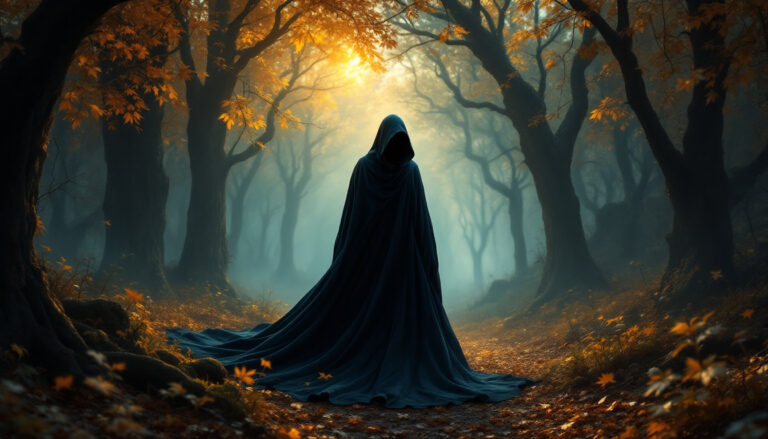A Court of Thorns and Roses – A Charming Tale of Love, Power, & Magic
Magic, danger, and passion collide in Sarah J. Maas’ A Court of Thorns and Roses, a book that has captured the hearts of fantasy and romance fans worldwide. Set in the mesmerizing realm of Prythian, the story follows Feyre, a young huntress pulled into the world of faeries after a fateful kill. With its mix of forbidden love, high-stakes challenges, and unforgettable characters, it’s no surprise this series has sparked a devoted following. Whether you’re drawn to the lush world-building or the slow-burn tension of its relationships, this book offers an adventure that’s impossible to put down.
The Alluring Plot and Fairy Tale Inspiration
Sarah J. Maas introduces readers to a captivating blend of high-stakes romance, danger, and an enchanting world that feels both familiar and entirely new. A Court of Thorns and Roses draws heavily on its fairy tale roots, with clear nods to Beauty and the Beast, but it reimagines the classic story in a way that adds complexity and emotional grit. At the heart of the story lies Feyre, a young woman desperate to survive but full of unyielding determination to protect those she loves. The winding plot, filled with twists, moral dilemmas, and heart-pounding romance, keeps readers glued to the pages.
Feyre’s Dilemma: From Hunter to Captive
Feyre’s journey begins out of sheer necessity. Starvation looms over her family, and she takes up a bow, venturing deeper into the woods than ever before. Her killing of a wolf, which turns out to be a fae in disguise, triggers the chain of events that forever alters her life. This bold decision showcases one of Feyre’s core qualities: her ability to step into danger head-on, even when it’s terrifying. But when Tamlin, a High Fae lord, arrives to claim justice, Feyre is thrust into a world far beyond her comprehension as a prisoner in the mesmerizing land of Prythian.
Her transition from hunter to captive doesn’t strip her of agency—far from it. Feyre navigates her new reality with a mixture of stubborn defiance and reluctant curiosity. She is torn between resentment for her captor and her gradual understanding that the fae world is not as black and white as the terrifying tales she was raised to believe. Moral decisions soon weigh heavily on her shoulders, forcing her to question her perception of justice, duty, and survival. Readers can’t help but wonder: What would you sacrifice for love or freedom?
For a deep dive into the complete plot and Feyre’s internal conflicts, check out this detailed summary.
Romance and Power Dynamics
As Feyre grows closer to Tamlin, the story dives into the layered nuances of their relationship. Tamlin, a once-powerful High Fae trapped under an ancient curse, initially remains distant but protective. His demeanor shifts with subtle vulnerability as he opens up to Feyre, but their expanding bond is never simple. Power imbalances linger between them, creating an undertow of tension. Tamlin wields authority while Feyre remains a human outsider struggling to find her footing in a magical world.
Unlike traditional fairy tales, their romance does not follow a straightforward path. Feyre isn’t swept off her feet into a dream-like state of bliss. Instead, Maas paints a more realistic picture of rising trust, missteps, and mutual growth. Hints of a possible love triangle emerge with the enigmatic Rhysand, adding intrigue to Feyre’s emotional journey. Does Tamlin, with his brooding charm and protective nature, truly hold Feyre’s heart, or is there more to learn about her desires and destiny?
The book’s foundation on Beauty and the Beast adds richness to the story. However, Maas infuses the tale with emotional depth, vivid stakes, and a focus on Feyre’s empowerment, making it feel original. For a closer look at how fairy tale elements weave into the narrative, you can explore this perspective in “Was ACOTAR really a retelling of Beauty and the Beast?”.
A Court of Thorns and Roses doesn’t just retell a fairy tale—it transforms it, presenting a story that both honors its roots and stands proudly on its own.
A World Beyond Imagination: Setting and Worldbuilding
Sarah J. Maas’ A Court of Thorns and Roses doesn’t just tell a story; it immerses you in a meticulously crafted world filled with beauty, danger, and magic. The setting of Prythian, with its Fae Courts and rich lore, serves as the backbone of this enthralling tale. The vivid landscapes and intricate systems of power and magic enhance the story, making it unforgettable for readers who long for an escape into a fully realized fantasy universe.
The Fae Courts: A Land of Beauty and Danger
The Spring Court, one of Prythian’s seven unique territories, stands as a key location in the book. Ruled by Tamlin, this court encapsulates themes of renewal, growth, and hidden peril beneath its pristine exterior. Its lands are described as eternally blooming, filled with vibrant gardens and lush forests that seem almost too perfect—a visual paradise that contrasts with the darker undercurrents of its ruler’s burdens and secrets.
But the Spring Court isn’t just backdrop scenery; it’s deeply symbolic in the story, often reflecting Tamlin’s duality. While it promises calm and rebirth, like the season it represents, it also hides thorns beneath the roses. Maas’ descriptive writing breathes life into the court, from golden sunlight filtering through blossoming trees to the faint hum of magic that seems to pulse in the air. It’s easy to lose yourself in its beauty, but the court reminds both reader and character alike that appearances can be deceiving.
Feyre’s time in the Spring Court is essential for her journey. As the story unfolds, you realize this court wasn’t just a refuge; it was a test of her resilience and a lens to examine what freedom and trust truly mean. Want to dig deeper? Learn more about the Spring Court’s significance and its role in the broader world of Prythian.
The Magic and Lore of Prythian
In Prythian, magic isn’t just a plot device; it’s the glue that binds this fantastical realm together. Each of the seven courts has its own unique magic tied to its High Lord, creating a layered system of power. The fae’s abilities range from subtle influences, like manipulating emotions, to raw displays of energy that shape the world itself—making magic an ever-present character as much as the protagonists themselves.
Magic in this world carries weight, with limitations that make it feel grounded. It’s not boundless; it’s tethered to traditions, like the Rite ceremonies where power is renewed and balanced. The interaction between magic and the land is almost symbiotic, creating a deeper connection for the courts and their rulers. Feyre, initially an outsider, gets thrust into this mystical framework, and her perspective allows readers to gradually unravel the mysteries of Prythian.
Equally crucial is the lore. From the wall that separates the Fae realm from the human world to the ancient wars that shaped the land, Maas gives readers a sense of history that stretches far beyond the events of the book. The result is a story steeped in cultural richness, complete with myths and legends that make the setting feel lived-in and tangible. Interested in diving into more details about Prythian’s magical foundations? Check out this helpful guide.
By blending enchanting landscapes, political intrigue, and a well-structured magic system, A Court of Thorns and Roses crafts a world so vivid it feels almost real. Every detail builds upon the last, pulling readers deeper and deeper into its captivating layers.
Characters Who Captivate and Challenge
In A Court of Thorns and Roses, Sarah J. Maas crafts characters that draw you in and keep you questioning their choices every step of the way. From Feyre’s personal transformation to the complex interplay of Tamlin and Rhysand, the characters are the heart of this story. They’re flawed, layered, and utterly compelling to both root for and critique.
Feyre: A Journey of Strength and Growth
Feyre Archeron’s transformation is the backbone of this series. When we first meet her, she’s a young woman driven purely by survival, hunting in the woods to keep her starving family alive. Her determination is admirable, but we see the cracks in her armor—she shoulders all the responsibility, sacrifices her dreams, and buries her vulnerability. Feyre isn’t superhuman; she’s raw, relatable, and utterly human.
Her journey to Prythian becomes a test of not just strength, but adaptability. At first, Feyre resists this world of faeries, clinging to her perceptions of mortals as inferior and helpless. Yet, as she begins to understand the complexities of fae politics and faces trials that test her bravery and wit, her inner power grows. Feyre doesn’t simply become “stronger” in the typical sense—she becomes more decisive, more self-aware, and more capable of advocating for her needs and desires.
Crucially, Maas doesn’t romanticize Feyre’s struggles. Her eventual rise as a powerful figure in the fae world comes at great personal cost. She endures heartbreak, betrayal, and the harsh realities of love and war. Feyre becomes a reflection of resilience in its truest sense—not just enduring pain, but evolving into someone capable of embracing her worth.
For a closer look at Feyre’s journey and the qualities that make her one of fantasy’s most iconic heroines, read this perspective: Why we love Feyre Archeron’s journey from survival to power.
Tamlin vs. Rhysand: Love, Loyalty, and Complexity
At the center of Feyre’s story is a compelling dynamic between two polar opposites: Tamlin and Rhysand. These two male leads shape Feyre’s emotional and personal evolution in vastly different ways, and their complexity gives the story much of its tension.
Tamlin, the High Lord of the Spring Court, initially appears as the classic tortured hero. His quiet strength and protectiveness draw Feyre closer during her early days in Prythian. However, over time, his actions reveal a darker side—one consumed by control and fear. His love for Feyre, while genuine, begins to suffocate her, becoming more about possession than partnership. Tamlin’s flaws make him an interesting character, but they also force readers to question the limits of loyalty. Can love truly justify his rigid dominance and unwillingness to adapt?
Enter Rhysand, the High Lord of the Night Court, who couldn’t be more different. Rhysand breaks the mold of what a “savior” is supposed to be. He’s cunning, calculating, and unapologetically honest about his motives. At first, his actions towards Feyre seem manipulative, even cruel. But as their bond deepens, it becomes clear that Rhysand values Feyre’s autonomy above all else. Where Tamlin stifles, Rhysand empowers. He challenges Feyre, helping her discover her strength in ways that allow her to truly own her decisions and power.
This contrast between the two High Lords provides rich moral tension. Tamlin represents safety and tradition, while Rhysand represents freedom and risk. Neither is perfect, but their opposing traits push Feyre—and the readers—to reconsider what love built on equality and trust should look like.
For an engaging comparison of these two characters and their impact on Feyre, check out this discussion: Rhys vs Tamlin.
Through Feyre’s relationships with Tamlin and Rhysand, Maas explores themes of loyalty, freedom, and personal growth. The love triangle isn’t just about choosing the “right” partner—it’s about Feyre learning to prioritize herself. And for readers, that journey is as satisfying as it is thought-provoking.
Themes That Resonate and Spark Debate
Sarah J. Maas’s A Court of Thorns and Roses doesn’t shy away from deeply emotional and often controversial themes. By weaving love, power dynamics, consent, and gender roles into her narrative, Maas challenges readers to think critically about relationships, identity, and personal growth. Let’s take a closer look at two central ideas that have sparked intense discussions within ACOTAR’s fan base.
Exploring Love and Consent: Analyzing Relationships
In A Court of Thorns and Roses, relationships aren’t painted in pure shades of black and white. They’re complicated, layered, and filled with moments that question societal norms. Maas presents love as both consuming and liberating, often blurring the lines between passion and control.
One of the most debated elements in the book is the portrayal of consent, particularly in the interactions between Feyre and Tamlin, as well as Feyre and Rhysand. Tamlin’s early relationship with Feyre carries all the hallmarks of a classic protector dynamic. Yet, as their bond develops, cracks begin to appear. His need to control and protect evolves into an oppressive force that stifles Feyre’s autonomy. For many readers, this raises an important question: when does love cross the line into possessiveness?
Rhysand, on the other hand, brings a nuanced perspective to the discussion of consent. While his initial treatment of Feyre during their time “under the mountain” is troubling to many, Maas gradually reveals layers to his character that challenge first impressions. Rhysand values Feyre’s choices, often giving her the space to make decisions for herself. Yet, his earlier actions—manipulative and cruel—cannot be overlooked. This dichotomy asks readers to wrestle with the idea of flawed redemption. Should someone’s reasons excuse their behavior? For a deeper dive into how consent is examined across the series, take a look at Desire and Consent in Sarah J. Maas’s Fictional Worlds.
Additionally, the evolution of these relationships parallels Feyre’s growth. Her choices reflect the broader theme of finding her voice. Whether facing Tamlin’s suffocating need for control or Rhysand’s initially questionable tactics, Feyre emerges as a character who learns to define love and partnership on her own terms.
Curious about ongoing critiques? This post on gender dynamics and abuse in the series offers some fascinating insights into the complexities Maas weaves into these themes.
Strength in Vulnerability: Examining Gender Roles
One of A Court of Thorns and Roses‘ standout achievements is its exploration of gender roles, both embracing and challenging traditional norms. Maas creates female characters who are strong not just because of their physical or magical abilities, but because of their vulnerability and emotional depth. Feyre’s journey exemplifies this balance, showing that strength doesn’t always mean stoicism.
From the start, Feyre takes on traditionally masculine responsibilities, hunting to provide for her family in a way that flips the expected provider dynamic. Yet, she also nurtures and supports her family emotionally, adding layers to what readers typically expect from a “strong female lead.” Through Feyre, Maas illustrates that strength and compassion aren’t mutually exclusive—they’re two sides of the same coin.
The depiction of male characters also walks the line between upholding and dismantling gender stereotypes. Tamlin embodies the archetype of a protective, dominant male figure. While he’s framed as charming and chivalrous early on, the narrative later shines a light on how those same traits can foster toxic dynamics. His inability to share power and his need to shield Feyre—even when she doesn’t ask for it—force readers to confront patriarchal ideals often glorified in stories like this.
Rhysand, by contrast, offers a more progressive interpretation of masculinity. He respects Feyre’s independence, encourages her growth, and demonstrates vulnerability in ways Tamlin rarely does. Rhysand’s willingness to embrace his emotional side, while steadily working to empower Feyre, sets him apart as someone working against the grain of traditional male fantasy tropes.
A key moment that underlines this theme is Feyre’s internal struggle to find power in different facets of vulnerability. Whether it’s acknowledging her trauma or leaning on those who support her, Feyre grows not by shutting others out but by redefining strength on her terms. This detailed fan study on gender roles and self-discovery in ACOTAR offers a thoughtful perspective on how Maas approaches this balance.
Ultimately, A Court of Thorns and Roses confronts readers with vital questions about love, power, and identity. Can strength emerge in embracing both traditional and nontraditional roles? How do the characters’ choices reflect real-world struggles with gender expectations? Maas doesn’t give easy answers, leaving readers to untangle the threads themselves. These deep explorations of gender and consent are part of what makes this series such a stirring conversation starter.
Conclusion
A Court of Thorns and Roses is a story that offers a fascinating blend of romance, action, and fantasy in a beautifully crafted world. Its strengths lie in Sarah J. Maas’s ability to create a vividly immersive setting, compelling character arcs, and emotional depth that resonates with readers. However, the book is not without its flaws, notably some problematic themes and predictable elements that may not work for everyone.
This is a perfect read for those who enjoy character-driven plots, morally complex relationships, and richly detailed fantasy worlds. Fans of fairy tale retellings with a darker, more mature twist will likely find this book captivating. Whether you’re new to fantasy or a seasoned reader, Feyre’s journey invites both questions and inspiration, making this novel a memorable escape.
What are your thoughts on this modern reimagining of classic tales? Share your perspective in the comments!







